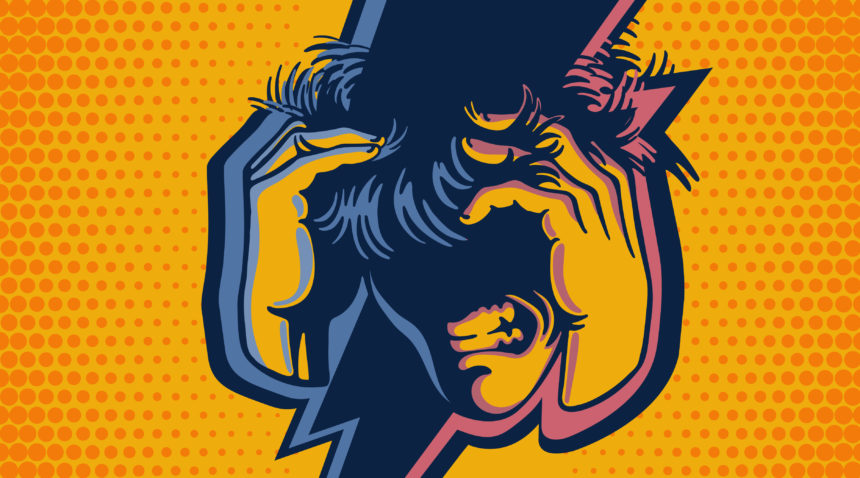Last month, a 34-year-old man participating in a hot-pepper-eating competition in Cooperstown, New York, went to the emergency room after he ate a Carolina Reaper, the world’s hottest pepper, according to Guinness World Records. The pepper is grown in Rock Hill, South Carolina.
But he didn’t go to the doctor because his mouth was on fire; he was in the emergency room with headache—a really bad and uncommon one, called a thunderclap headache.
So, what is a thunderclap headache? And is it really possible to get one from eating hot peppers? We talked with Gary W. Jay, MD, clinical professor of neurology at the UNC School of Medicine, to find out.
What is a thunderclap headache?
A primary thunderclap headache has four components: You have severe head pain with sudden onset. It peaks in less than a minute, which means you go from zero to 100 in less than 60 seconds, and it lasts at least five minutes.
But it’s also possible that a thunderclap headache could be a sign of another problem. This is a secondary thunderclap headache, caused by another condition.
For anyone who walks into the emergency room with a thunderclap headache, you have to rule out about a dozen different disorders before you can say, “This is a primary thunderclap headache, not a thunderclap headache that is secondary to another issue.”
What kinds of conditions cause secondary thunderclap headaches?
The list of differential diagnoses for thunderclap headaches is pretty long. Subarachnoid hemorrhage, or a type of bleeding in the brain, is the most common, and the main symptom is a sudden, severe headache. Unruptured brain aneurysms cause sentinel leaks, where a little blood comes out even though it’s unruptured, and this blood in the spinal cord will cause severe pain. Ruptured aneurysms, small tears in the arteries of your head or neck, blocked veins, rapid changes in blood pressure and an infection in your brain can all also be causes of secondary thunderclap headaches. Most of these issues are very serious and need immediate care.
Can a very hot pepper trigger a thunderclap headache?
Fortunately, there are not a lot of common triggers for thunderclap headaches. Cold food and drinks, for example, might produce the “brain freeze” headache, but not a true thunderclap headache.
But in the case of fiery peppers such as the Carolina Reaper, capsaicin, which is the chemical that causes the heat or spiciness, might be one of those rare triggers. In fact, a rare condition called reversible cerebral vasoconstriction syndrome (RCVS), where blood vessels that supply blood to the brain suddenly constrict and tighten—the main symptom of which is a thunderclap headache—was first discovered in 2001 in a person who had developed a thunderclap headache after eating hot peppers.
How are thunderclap headaches different from other severe headaches, such as migraines or cluster headaches?
One of the biggest differences between migraines and thunderclap headaches is that with a migraine, the pain doesn’t start off that severe within a minute; it takes time to have pain that is significant, typically 20 to 30 minutes at a minimum.
Unlike thunderclap headaches, which come with no warning, 20 percent of people who experience migraines get them with auras, which means they will get a warning of an oncoming migraine about 30 to 60 minutes before the headache through visual symptoms or sensory or speech problems.
A cluster headache is the most severe form of headache, in that you can get one to eight of them a day, and they can last 45 minutes to three hours. They are so severe that people often can’t sit or lie down. Some even harm themselves to try to stop the pain, by actions such as striking their head against a wall.
There’s often no way to tell what kind of headache you’re having; the best course of action is to seek emergency care whenever you or someone near you is experiencing a very severe headache, especially if it’s sudden or different from typical headaches. If it is a first-time severe headache, such as a thunderclap headache, you should go to the emergency department as soon as possible.
Is it possible to prevent thunderclap headaches?
Migraines and cluster headaches both have medications that can prevent or stop the pain, but there is no medication equivalent for thunderclap headaches. Thunderclap headache comes out of the blue, and you might only have one in your life, although the majority of headache patients don’t get even one. There’s no way to know who’s going to get it. If you do get a thunderclap headache, you should go to the emergency department immediately to rule out a bleed or other potentially life-threatening causes.
Struggle with headaches? Talk to a doctor near you about finding relief.

